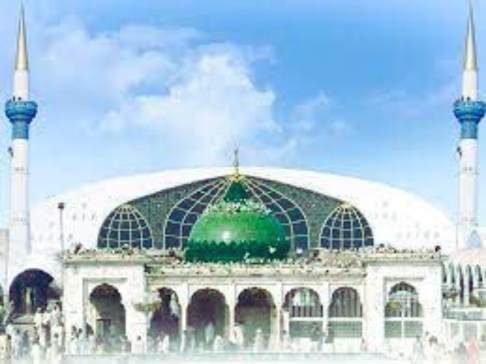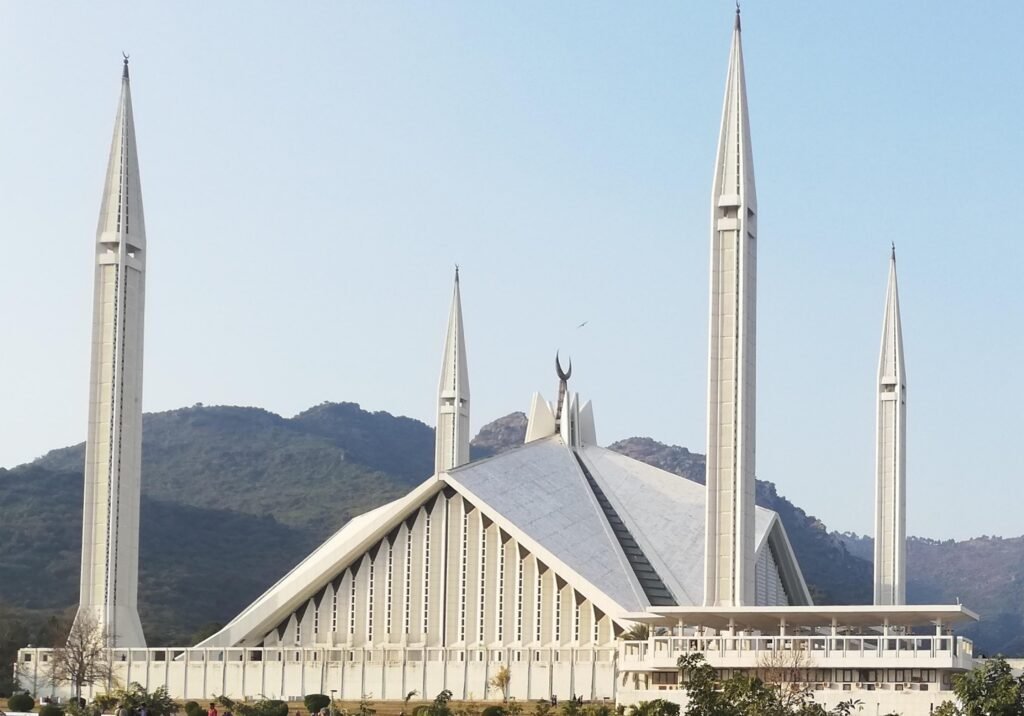Hazrat Data Gunj Bakahsh stands with spiritual legacy In the heart of Lahore, Pakistan, ,echoing through the centuries. He is also Known as Hazrat Sheikh Abul Hassan Ali Ibn Usman al-Jullabi al-Hajvery al-Ghaznawi, or Abul Hassan Ali Hajvery.
He was Born in the lands of Ghazni, Afghanistan during the 11th century. He was a member of the Syed family, which is descended from the Holy Prophet.He was Author of a famous book on mysticism, and one of the most successful Sufi preachers on the subcontinent and is today one of the most famous Sufi saints in Pakistan.
He finished his previous schooling in Ghazni by learning the entire Holy Quran by heart. After that, he studied philosophy, Hadith, Arabic, Farsi, and Fiqh. Sultan Mahmood Ghaznavi, the well-known Afghan king, ruled Ghazni, which at the time served as the educational hub of Central Asia.
He looked for the spiritual education after finishing the worldly education. For this reason, he traveled to several locations before ultimately settling in Syria to become the spiritual pupil of Hazrat Abul Fazal Mohammad bin Khatli of the Junaidiya Sufi Order.
Under the direction of Hazrat Abul Fazal, Hazrat Ali Hajveri began his spiritual training in Syria. He fasted, ate less, and engaged in challenging meditation and contemplation. Subsequently, he visited numerous nations and locations, including Iran, Iraq, Syria, Turkey, Arabia, Azerbaijan, etc.
He met a lot of Sufi saints and dervishes there.He once became entangled in a spiritual challenge that he was unable to understand, so he traveled to Hazrat Bayazid Bistami’s grave and meditated there for several days before finally solving the problem.
He entangled and visited Hazrat Bayazid Bistami’s mausoleum on a different day, but this time he came up empty-handed. After that, he traveled to the Iranian province of Khurasan and settled in a village there, where he came into a group of Sufi dervishes.
Since Hazrat Ali Hajveri consistently wore plain clothing, the Sufis among themselves whispered to one another that Ali Hajveri didn’t belong in their company (since they were all dressed like dervishes).
They enjoyed delectable meals while Hazrat Ali Hajveri stayed with them, and they gave him some dry bread to eat. They also tossed fruit crusts at Hazrat Ali Hajveri, making fun of him. “O God, if these people wouldn’t be wearing the clothes of your friends (dervishes), then I wouldn’t tolerate their insulting behavior,” Hazrat Ali Hazjveri said in reference to God.
He paid a visit to Hazrat Bilal’s tomb, the illustrious companion of the Holy Prophet, while traveling through Syria. After a time, he fell asleep there and awoke at Makka. There, he saw the Holy Prophet with an elderly man.
Unable to identify him, he wondered who he may be. Then Hazrat Ali Hajveri kissed the Holy Prophet’s feet after falling on them. “This old man is Abu Hanifa, your Imam,” the Holy Prophet informed Hazrat Ali Hajveri, knowing what was going through Hazrat Ali’s mind.
Subsequently, Hazrat Abul Fazal, his spiritual mentor, gave him the command to travel to Lahore and spread the Islamic spiritual teachings. “Why should I go there when Hazrat Shah Hussain Zanjani is already there for this purpose?” he remarked.
“Just go to Lahore; it’s none of your business,” Hazrat Abul Fazal said.
He then traveled to Ghazni from Syria. He traveled to Peshawar and subsequently Lahore in 1041 A.D. (431 A.H.) from Ghazni. Upon arriving in Lahore, he observed that a coffin was being moved toward a graveyard for burial.
Who is he, he inquired? The response from the public was that it was Hazrat Shah Hussain Zanjani’s dead body. That’s when he realized why Hazrat Abul Fazal, his instructor, had sent him to Lahore. He began preaching Islam and constructing a mosque in Lahore after arriving there.
Sultan Mahmood Ghaznavi ruled the Ghazni Kingdom at the time, which encompassed Lahore. And Ra’e Raju, the Hindu governor of Lahore, possessed numerous extraordinary spiritual talents. Lahoris used to provide Ra’e Raju with large amounts of milk as a capitation.
An elderly woman carrying a milk-filled water pot was once in route to pass in front of Hazrat Data Gunj Baksh Ali Hajveri R.A. She was instructed to provide some milk to Hazrat Data Gunj Baksh Ali Hajveri R.A. from that. Refusing, the woman stated that she must give it to Ra’e Raju.
“Give some milk to me, by the grace of God, your cow will produce much more milk than usual,” Hazrat Data Gunj Baksh Ali Hajveri R.A. stated. After receiving the pot from the woman, Hazrat Ali Hajveri drank some milk and dumped the rest into the river.
The elderly woman was shocked to find her cow’s milk-filled breasts when she arrived home. The cow’s breasts were still full even after she filled all of her pots with milk.
As soon as this information circulated around Lahore, people began to visit Hazrat Ali Hajveri. They all brought milk for him, and he also drank some from their pots before discarding the rest into the river. As a result, all of their cows began to yield more milk. Thus, they ceased providing milk to Ra’e Raju.
Ra’e Raju later dispatched one of his disciples—who also possessed mystical abilities—to Hazrat Data Gunj Baksh Ali Hajveri R.A. Ra’e Raju dispatched another disciple when that one failed to return, but this disciple did not either. He sent all of his followers in this manner, but none of them returned. In a fit of rage, he finally rushed to Hazrat Ali Hajveri himself. Hazrat Ali Hajveri was challenged by Ra’e Raju to perform any miracle for him.
In response, Hazrat Ali Hajveri said, “I’m not a juggler.” Hazrat Ali Hajveri gave the order for Ra’e Raju’s shoes to bring him down as he attempted to dazzle him with his miracles and began to soar over the skies. Thus, the flying Ra’e Raju was struck in the head and brought down by the shoes of Hazrat Ali Hajveri. Inspired, Ra’e Raju accepted Islam with both hands. He became Shaikh Ahmed Hindi after converting to Islam.
When Hazrat Ali Hajveri constructed a mosque in Lahore, it was unique from all other mosques in the city since its front faced south. Thus, there was some uncertainty as to why this mosque faces away from Ka’ba.
The Lahore Scholars voiced their objections regarding that mosque, but Hazrat Ali Hajveri did not respond. He called all of Lahore’s academics when the mosque was finished, telling them, “You objected over this mosque’s Ka’ba direction, now look by yourself in which direction Ka’ba actually is!”
They noticed Ka’ba when they turned to face her in Makka, where they were seated. After seeing that, every scholar felt embarrassed and apologized.
In addition, Hazrat Data Gunj Baksh Ali Hajveri R.A. constructed a room next to the mosque, which was used as the Khanqa (Spiritual School). Under his instruction, many unbelievers came to adopt Islam, while many others attained higher spiritual states. He had two marriages, but both of them ended in divorce. “Hasan” is the name of his son.
After spending twenty-one years in Lahore, he traveled to Syria to visit Hazrat Abul Fazal, his spiritual mentor. And he returned to Lahore upon Hazrat Abul Fazal’s passing in 453 A.H.
Israrul Kharq Wal-Mauniyat, Behrul Quloob, Kitab Fana Wa Baqa, Birri’ayat Be-Huqooq-Ullah, Kashful Israr, Sharah-e-Kalam, and Kashful Mahjub are only a few of the numerous publications written by Hazrat Data Gunj Baksh Ali Hajveri R.A.
at 465 A.H., he passed away at Lahore at the age of 65.
During his two-week stay at Hazrat Ali Hajveri’s tomb in Lahore in 561 A.H. (1165 AD), Khwaja Moinuddin Chishti engaged in meditation. After concluding his meditation, he said the following Farsi couplet:
Ganj Bukhsh Faiz-e-Alam;
Mazhar-e-Noor-e-Khuda
Naqisa-ra Pir-e-Kamil
Kamila-ra Rahnuma;


